How Long Does Ground Coffee Last in the Fridge
While you can store ground coffee in the fridge, it's not the ideal storage method as it can lead to moisture issues and flavor degradation. Ground coffee stored in the fridge typically lasts 1-2 weeks when properly sealed, but you'll notice a decline in taste quality. The refrigerator's humidity can cause condensation when you remove and open the container, potentially leading to mold growth and staleness. Your best option is to store ground coffee in an airtight, opaque container at room temperature (68-77°F), where it'll maintain maximal freshness for up to 2 weeks. Understanding proper storage techniques can greatly extend your coffee's shelf life and preserve its rich flavor profile.
This post may contain affiliate links. If you make a purchase through these links, I may earn a commission at no additional cost to you. Additionally, portions of this post may be generated using artificial intelligence (AI) technology. While we strive for accuracy, please be aware that AI-generated content may not always be perfect and should be fact-checked when necessary.
The Spatula Scoops
- Ground coffee can last 3-5 months in the fridge but risks moisture damage and odor absorption from other foods.
- Refrigeration is not recommended as it causes condensation when containers are opened, potentially degrading coffee quality.
- Store ground coffee at room temperature (68-77°F) in an airtight, opaque container for optimal freshness and flavor.
- If using refrigeration, ensure coffee is in vacuum-sealed bags and allow 30-45 minutes for temperature stabilization before opening.
- Check for mold, rancid smells, or unusual texture in refrigerated coffee, as moisture exposure increases spoilage risk.
Ground Coffee Storage Basics
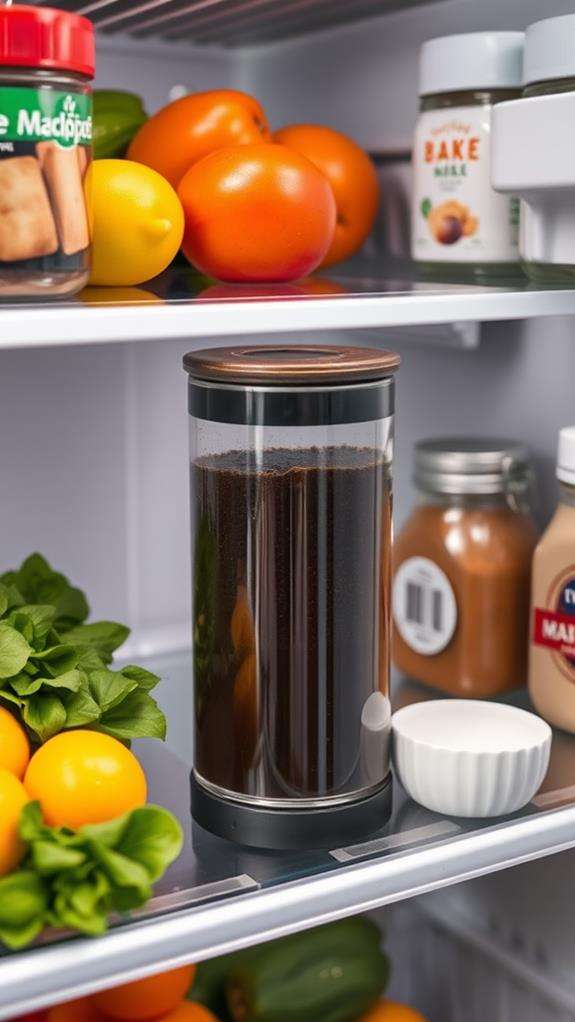
Storing your ground coffee properly can mean the difference between a fresh, flavorful cup and a stale, disappointing brew. You'll want to focus on four key factors that affect coffee's longevity: temperature, moisture, air exposure, and light.
Ground coffee is particularly vulnerable to degradation because its increased surface area exposes more of the coffee to environmental factors. When you're storing your grounds, you'll need an airtight container that's opaque and moisture-resistant. While many people default to storing coffee in the original packaging, that's not your best option for long-term storage.
The best containers for ground coffee include ceramic canisters with airtight seals, glass jars with rubber gaskets, or specialized coffee storage containers with one-way valves that release CO2 but don't let oxygen in. You'll want to keep these containers in a cool, dark place away from direct sunlight and heat sources. Don't store them near your stove or on countertops that get morning sun. While the fridge might seem like a logical storage solution, it's actually not ideal due to moisture concerns and temperature fluctuations when you remove and replace the container.
Ideal Storage Temperature
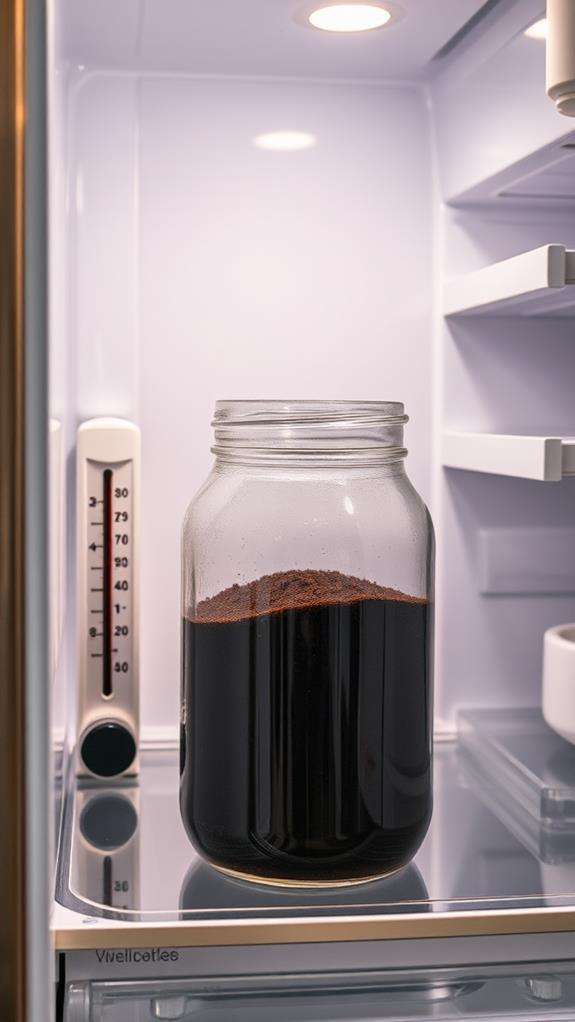
While you might think storing ground coffee in your fridge keeps it fresher, the ideal storage temperature actually falls between 68-77°F (20-25°C), making room temperature the better choice. Your refrigerator's cold environment can create condensation when the container is opened and closed, introducing unwanted moisture that can degrade your coffee's quality faster than proper room-temperature storage. The cooling effect of refrigeration can also cause your coffee grounds to absorb odors from other foods, even in an airtight container, which will negatively impact the flavor of your morning brew.
Cold Vs Room Temperature
The ideal temperature for storing ground coffee typically falls between 50-70°F (10-21°C). You'll notice significant differences between cold and room temperature storage, particularly in how they affect your coffee's flavor compounds and shelf life.
| Storage Method | Pros | Cons |
|---|---|---|
| Room Temperature | Maintains natural oils | 1-2 weeks shelf life |
| Refrigerator | Extends shelf life | Moisture concerns |
| Freezer | Longest preservation | Flavor degradation |
While you might think the fridge is your best option, room temperature storage often provides better results for your daily coffee needs. The cold environment can introduce unwanted moisture when you repeatedly open and close the container, potentially leading to flavor deterioration. You'll want to avoid temperature fluctuations, which can cause condensation and accelerate the degradation process. If you're storing your coffee at room temperature, keep it in an airtight container away from heat sources and direct sunlight. For longer-term storage beyond two weeks, you might consider freezing portions of your ground coffee in vacuum-sealed bags, though you'll sacrifice some flavor complexity in exchange for extended shelf life.
Temperature Range for Storage
Maintaining ground coffee at specific temperatures proves essential for preserving its quality and flavor. You'll want to keep your ground coffee within a temperature range of 50-70°F (10-21°C) for ideal storage conditions. When storing in the fridge, aim for a consistent temperature around 40°F (4°C), though you should be aware that frequent temperature fluctuations can lead to condensation issues.
While your refrigerator might seem like a logical storage solution, you'll need to take into account that the ideal storage temperature actually falls closer to room temperature. If you're storing coffee in warmer climates, you shouldn't let the storage environment exceed 75°F (24°C), as higher temperatures can accelerate the oxidation process and degrade your coffee's essential oils. You'll find that basement storage often provides the perfect temperature range, typically maintaining a steady 55-65°F (13-18°C). When using your refrigerator, you must make sure your coffee is in an airtight container to prevent moisture absorption and temperature shock when removing it for use. Remember that consistent temperature matters more than achieving a specific number within the acceptable range.
Moisture and Cooling Effects
Storing ground coffee in cold environments creates unique challenges due to moisture concerns. When you place your ground coffee in the fridge, the cooling effect can cause condensation to form, particularly when you remove the container and expose it to warmer room temperatures. This moisture interaction can greatly impact your coffee's quality and shelf life.
Your ground coffee's exposure to moisture in the refrigerator can lead to several issues:
- Accelerated degradation of essential flavor compounds
- Formation of mold and bacterial growth in humid conditions
- Absorption of unwanted odors from other foods
- Clumping of coffee grounds, making brewing more difficult
You'll notice that the temperature fluctuations between cold storage and room temperature create a cycle that's particularly harsh on your ground coffee. Each time you open the container, you're introducing new moisture through condensation. To minimize these effects, you'll want to store your coffee in an airtight container and allow it to reach room temperature before opening. If you must refrigerate your ground coffee, consider dividing it into smaller portions that you can use immediately upon removal, reducing the number of temperature cycles the coffee experiences.
Moisture and Coffee Freshness
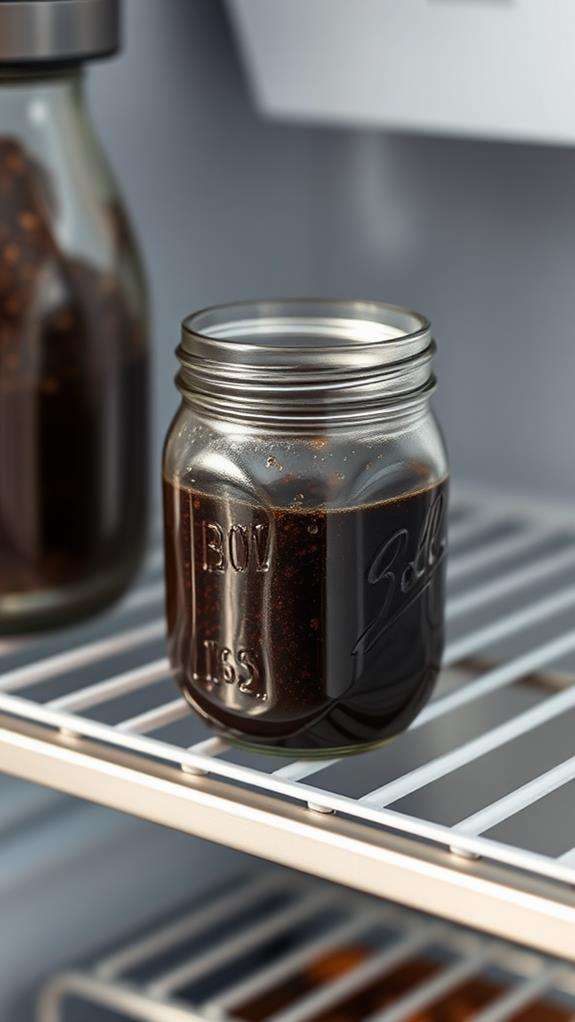
When you store ground coffee in your fridge, you'll need to watch out for moisture, which can quickly turn your beans stale and affect their rich flavor profile. While cold temperatures might seem ideal for preservation, the condensation that forms when you remove the coffee container from the fridge can introduce unwanted moisture into your grounds, leading to quality degradation and potential mold growth. You can protect your coffee by using an airtight container with a good seal, placing a moisture-absorbing packet inside, and letting the container reach room temperature before opening it to prevent condensation from forming on your precious grounds.
Effects of Cold Storage
Cold storage temperatures can considerably impact your ground coffee's freshness and overall quality through moisture-related issues. When you store ground coffee in your refrigerator, you're exposing it to temperature fluctuations and condensation that can accelerate degradation. Each time you remove the container from the fridge, warm air hits the cold coffee, creating moisture that seeps into the grounds.
You'll notice several detrimental effects when storing your coffee in cold environments:
- Oxidation accelerates due to condensation, causing your coffee to lose its distinctive flavors more quickly
- Volatile compounds responsible for aroma become less stable at fluctuating temperatures
- Coffee grounds can absorb odors from other foods in your refrigerator
- Moisture accumulation leads to potential mold growth and bacterial development
To maintain your coffee's quality, you're better off storing it in an airtight container at room temperature, away from direct sunlight and heat sources. If you must refrigerate your coffee, make sure it's in a truly airtight container and let it reach room temperature before opening to minimize condensation. The temperature stabilization process typically takes 30-45 minutes, depending on your room's ambient conditions.
Preventing Condensation Formation
Protecting your ground coffee from condensation requires careful attention to moisture control techniques. When you're storing coffee in the fridge, you'll need to create an effective moisture barrier to prevent water droplets from forming and compromising your coffee's quality.
To minimize condensation, you'll want to use an airtight container with a secure seal and always verify it's completely dry before adding your coffee. Don't transfer cold coffee directly to room temperature, as this rapid temperature change will create condensation inside the container. Instead, let the container gradually warm up while keeping it sealed.
You can also add moisture-absorbing packets, similar to silica gel packs, to your coffee container, but make sure they're food-grade and kept separate from the grounds. When you're ready to use your coffee, take out only what you need rather than removing the entire container from the fridge. If you notice any moisture building up on the container's walls, transfer your coffee to a fresh, dry container immediately. Additionally, consider using vacuum-sealed bags with one-way valves, which will help prevent both moisture accumulation and flavor loss.
Moisture Control Methods
Coffee's long-term freshness depends heavily on effective moisture control during refrigeration. You'll need to implement several proven methods to maintain ideal storage conditions and prevent your ground coffee from absorbing unwanted moisture.
To effectively control moisture in your refrigerated coffee, you'll want to use airtight containers with proper sealing mechanisms. These containers should include moisture-absorbing elements such as:
- Food-grade silica gel packets to trap excess moisture
- Vacuum-sealed bags with one-way degassing valves
- Ceramic storage containers with airtight rubber seals
- Double-lid systems with moisture-barriers built in
You can enhance these storage methods by placing your coffee container in the least humid part of your fridge, typically the middle shelf. Don't store it near items that regularly produce condensation, like fresh produce or dairy products. If you notice any condensation forming inside your storage container, transfer the coffee to a new, dry container immediately and add a fresh moisture-absorbing packet. Remember to check your stored coffee regularly for signs of moisture intrusion, such as clumping or changes in texture, which indicate it's time to adjust your storage method.
Signs of Spoiled Coffee
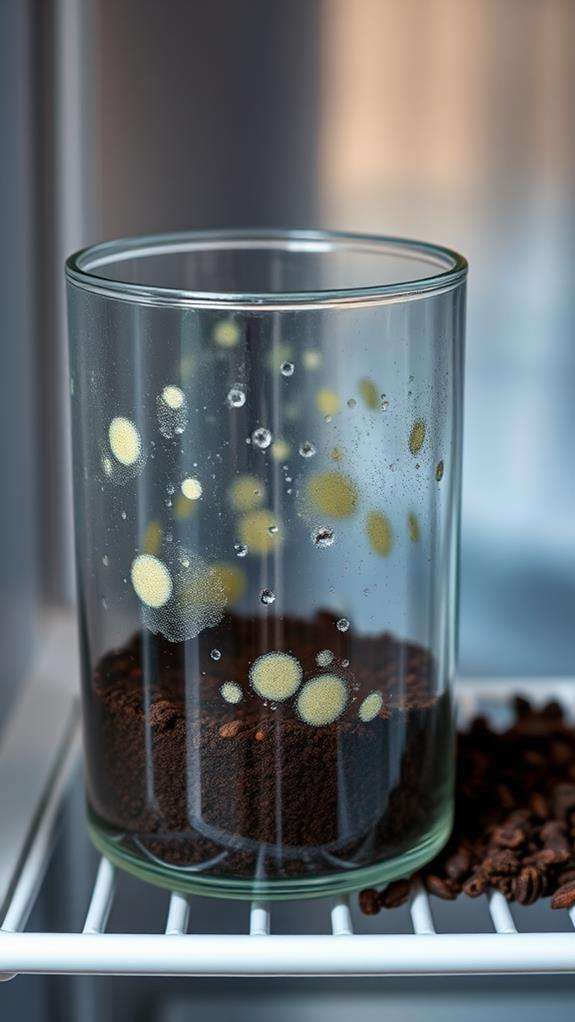
Several telltale signs will let you know if your ground coffee has gone bad in the fridge. You'll want to check for visual, aromatic, and textural indicators that signal it's time to discard your coffee grounds.
| Warning Sign | What to Look For | Action Needed |
|---|---|---|
| Visual Changes | Mold spots, discoloration, or clumping | Discard immediately |
| Aroma Issues | Rancid, musty, or chemical smell | Replace with fresh grounds |
| Texture Problems | Excessive moisture, hardened chunks | Don't use; throw away |
When you're examining your stored coffee, pay close attention to any unusual developments. If you notice white or greenish spots, that's mold growth, and you'll need to dispose of the grounds right away. Your coffee shouldn't smell like chemicals, cardboard, or anything rotten – if it does, it's past its prime. The texture should remain loose and relatively dry; if you find wet patches or hard lumps, moisture has compromised your coffee's quality. You might also notice that spoiled coffee loses its characteristic rich brown color, taking on a dull, grayish appearance. Don't take chances with questionable coffee – when in doubt, throw it out.
Fridge Vs Room Temperature

The debate between storing coffee in the fridge versus at room temperature often leads to confusion among coffee enthusiasts. While you might think refrigeration preserves coffee better, room temperature storage actually offers several advantages for maintaining your coffee's quality.
When you store coffee at room temperature in an airtight container, you'll preserve its natural oils and flavors more effectively. Refrigeration can expose your coffee to moisture and temperature fluctuations, which can degrade its quality faster. Here's what you need to evaluate when choosing between fridge and room temperature storage:
- Room temperature storage keeps coffee away from condensation that can form in the fridge, preventing moisture damage
- Temperature fluctuations in the fridge can cause coffee to repeatedly expand and contract, breaking down its molecular structure
- Refrigerated coffee often absorbs odors from other foods, affecting its taste profile
- Counter storage allows for easier access and consistent brewing temperatures
If you're determined to use cold storage, you'll need to verify your coffee is in a truly airtight container and limit its exposure to temperature changes by keeping it in the back of your fridge where temperatures remain most stable.
Preserving Coffee Flavor
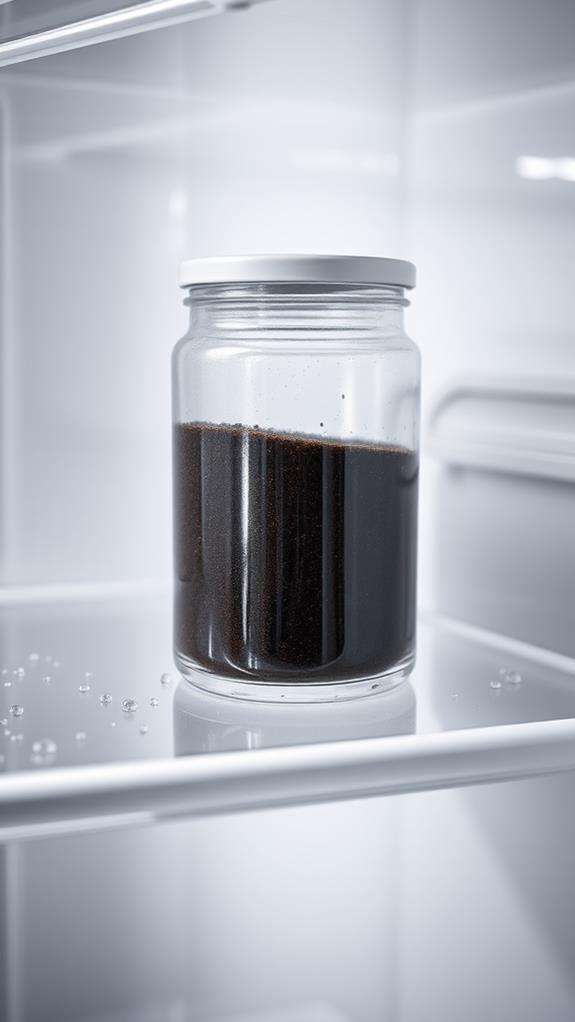
Maintaining ideal flavor in your ground coffee requires understanding key preservation techniques. You'll need to focus on four critical factors: temperature control, moisture prevention, light exposure, and container selection. Each element plays an essential role in preserving your coffee's aromatic compounds and crucial oils.
| Factor | Impact on Coffee Flavor |
|---|---|
| Temperature | Fluctuations accelerate oxidation |
| Moisture | Triggers premature degradation |
| Light | Breaks down flavor compounds |
| Air Exposure | Causes staleness and rancidity |
To maximize flavor retention, you'll want to store your ground coffee in an opaque, airtight container with a one-way valve that releases CO2 but prevents oxygen from entering. While the fridge offers temperature stability, you shouldn't repeatedly move coffee between cold and room temperature environments, as this creates condensation. Instead, portion out what you'll use within a week and keep it in a separate container at room temperature. For the remainder, make sure your storage container is completely sealed before placing it in the fridge. You'll also want to avoid opening the container while it's cold, as this can introduce unwanted moisture and compromise the coffee's flavor profile.
Air-Tight Container Benefits
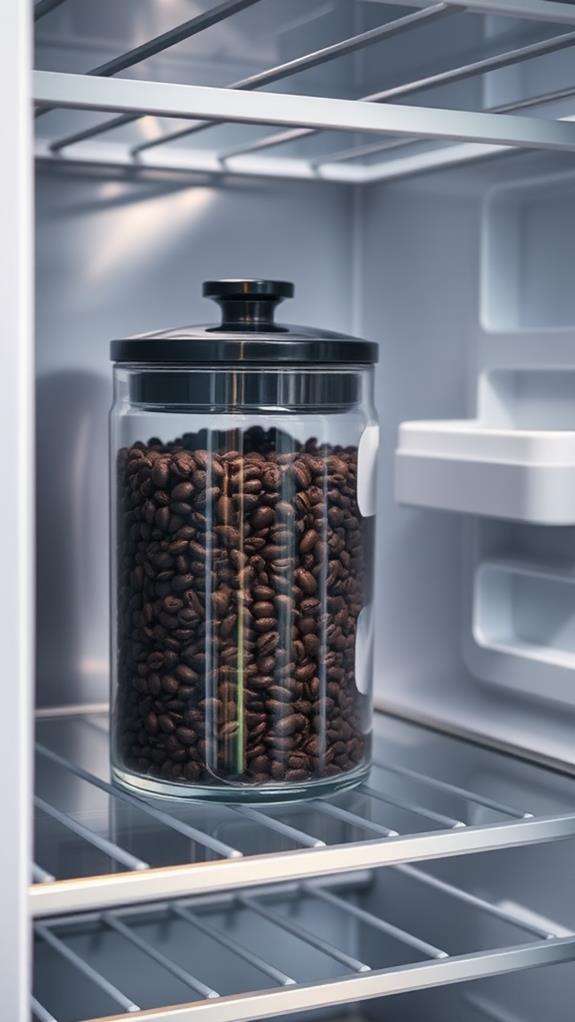
Proper storage containers offer notable advantages when preserving your ground coffee's freshness, building on the storage principles we've discussed. When you're storing coffee in your fridge, an air-tight container becomes your most valuable ally against flavor degradation and moisture absorption.
The best air-tight containers provide several key benefits that directly impact your coffee's longevity and taste:
- Create an impermeable barrier against external odors that could contaminate your grounds
- Prevent moisture from causing clumping and potential bacterial growth
- Maintain consistent temperature by reducing thermal fluctuations
- Block UV light exposure, which can break down coffee's natural compounds
You'll want to choose containers with high-quality seals, preferably made from non-reactive materials like ceramic or stainless steel. If you're using plastic containers, verify they're food-grade and BPA-free. The container's size should match your coffee quantity – you don't want excess air space that could lead to oxidation. When selecting your container, look for features like vacuum seals or one-way valves, which can help release built-up CO2 without letting oxygen in. These specialized features might cost more initially, but they'll greatly extend your coffee's shelf life.
Best Coffee Storage Methods
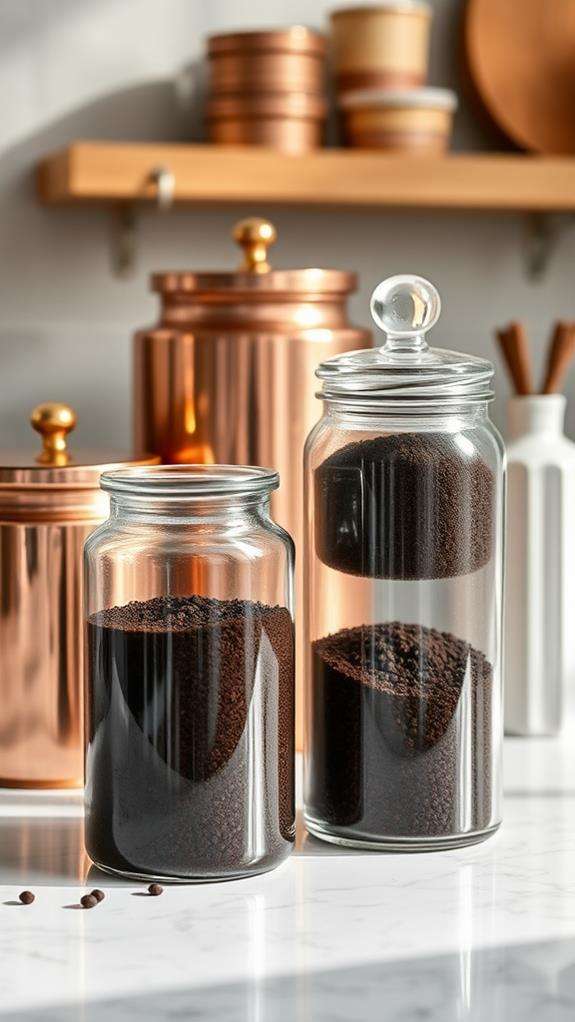
Expert baristas swear by multiple storage methods that can greatly extend your ground coffee's shelf life. You'll want to focus on keeping your coffee away from its four main enemies: heat, moisture, light, and air. Each storage method offers different benefits, and you'll need to take into account the one that best fits your needs and coffee consumption habits.
Storage Method | Best For
————–|———-
Vacuum Sealer | Long-term storage, bulk purchases
Mason Jars | Weekly use, moderate humidity
Coffee Vaults | Daily use, high humidity areas
Beyond these container options, you'll need to take into account location and temperature control. Store your coffee in a cool, dark place like a pantry or cabinet rather than on your countertop. If you're using the fridge, you'll want to double-wrap your coffee to prevent moisture absorption and flavor contamination. The freezer can work for long-term storage, but you'll need to use moisture-proof, vacuum-sealed bags to prevent freezer burn. Remember to only remove what you'll use immediately, as temperature fluctuations can cause condensation and degrade your coffee's quality faster.
Frequently Asked Questions
Can Frozen Ground Coffee Be Directly Used in a Coffee Maker?
Yes, you can use frozen ground coffee directly in your coffee maker, but you'll get better results if you let it thaw first. When you use frozen grounds immediately, the extreme temperature difference can affect extraction and potentially create condensation in your machine. For the best flavor, take out the amount you need and let it sit at room temperature for 15-20 minutes before brewing. This small wait helps preserve the coffee's ideal taste.
Does Grinding Coffee Beans Before Refrigeration Affect Their Storage Life?
Yes, grinding your coffee beans before refrigeration does affect their storage life. When you grind coffee beans, you're increasing their surface area exposure to air, moisture, and other elements, which speeds up the degradation process. You'll find that whole beans can last 2-3 weeks in the fridge, while ground coffee typically stays fresh for only 1-2 weeks. If you're planning long-term storage, it's better to keep your beans whole.
Will Mixing Different Coffee Brands in Storage Impact Their Individual Flavors?
When you mix different coffee brands during storage, you'll notice that their distinct flavors can blend and influence each other. Coffee beans naturally release oils and gases that can transfer between varieties, especially in shared containers. You'll want to store different coffee brands separately to maintain their unique taste profiles. If you must combine them, use airtight containers with dividers, and try to keep strongly flavored coffees away from milder ones.
Can Refrigerated Ground Coffee Absorb Odors From Other Foods?
Ever wondered why your coffee suddenly tastes like last night's leftovers? Yes, your refrigerated ground coffee can definitely absorb odors from other foods. Coffee's porous nature makes it act like a sponge for nearby smells. You'll want to store your grounds in an airtight container to protect them from absorbing unwanted odors. Even then, you're better off keeping your ground coffee in a cool, dark pantry instead of the fridge.
Should Ground Coffee Be Brought to Room Temperature Before Brewing?
You don't need to bring refrigerated ground coffee to room temperature before brewing, but doing so can help guarantee prime flavor extraction. When you use cold grounds, the hot water cools slightly upon contact, which might affect the brewing temperature and extraction process. If you're pursuing the perfect cup, let your grounds sit out for 15-20 minutes before brewing, though you'll still get decent results brewing straight from the fridge.





